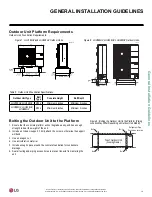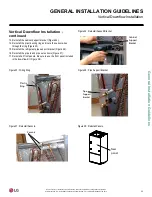
INTRODUCTION | 33
General Refrigerant Piping System Information
Due to our policy of continuous product innovation, some specifications may change without notification.
©
LG Electronics U.S.A., Inc., Englewood Cliffs, NJ. All rights reserved. “LG” is a registered trademark of LG Corp.
Figure 34: Installing Piping Above and Below an Obstacle.
Obstacles
When an obstacle, such as an I-beam or concrete T, is in the path
of the planned refrigerant pipe run, it is best practice to route the
pipe over the obstacle. If adequate space is not available to route
the insulated pipe over the obstacle, then route the pipe under the
obstacle. In either case, it is imperative the length of the horizontal
section of pipe above or below the obstacle be a minimum of three
(3) times the longest vertical rise (or fall) at either end of the
segment.
MINIMUM
Above an obstacle
MINIMUM
Below an obstacle
3X
X
3X
X
Pipe Supports
A properly installed pipe system must be adequately supported to avoid pipe sagging. Sag-
ging pipes become oil traps that lead to equipment malfunction.
Pipe supports must never touch the pipe wall; supports shall be installed outside (around) the
primary pipe insulation jacket. Insulate the pipe first because pipe supports shall be installed
outside (around) the primary pipe insulation jacket. Clevis hangers must be used with shields
between the hangers and insulation. Field provided pipe supports must be designed to meet
local codes. If allowed by code, use fiber straps or split-ring hangers suspended from the
ceiling on all-thread rods (fiber straps or split ring hangers can be used as long as they do not
compress the pipe insulation). Place a second layer of insulation over the pipe insulation jacket
to prevent chafing and compression of the primary insulation within the confines of the support
pipe clamp.
A properly installed pipe system must have sufficient supports to avoid pipes from sagging
during the life of the system. As necessary, place supports closer for segments where poten-
tial sagging could occur. Maximum spacing of pipe supports shall meet local codes.
Wherever the pipe changes direction, place a hanger within twelve (12) inches on one side
and within twelve (12) to nineteen (19) inches of the bend on the other side.
Figure 35: Pipe Hanger Details.
Use a 4" + long sheet curved sheet metal
saddles between hanger bracket and insula-
tion to promote linear expansion/contraction.
Figure 36: Typical Pipe Support Location—
Change in Pipe Direction.
Max. 12"
~ 12" – 19"
REFRIGERANT SYSTEM ENGINEERING
Summary of Contents for LV181HV4
Page 73: ...NOTES ...
















































